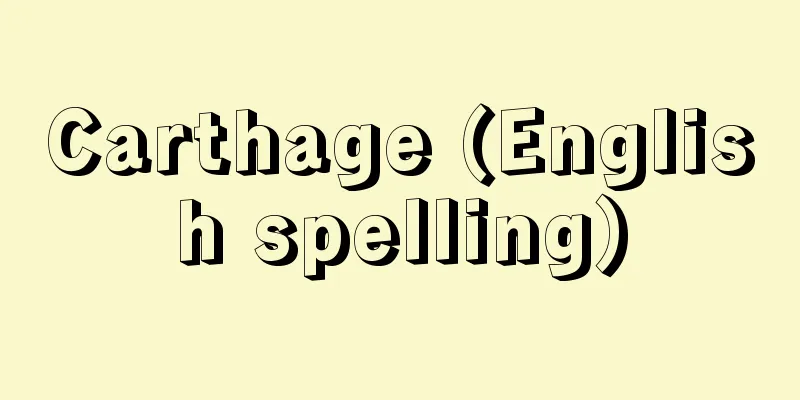Carthage (English spelling)

The most prosperous ancient city in North Africa. Located about 16km northeast of Tunis, the capital of present-day Tunisia, on a triangular peninsula jutting out into the Mediterranean Sea, Carthage was blessed with an extremely advantageous geographical location for defense, with Lake Tunis, which was rich in fish and suitable for anchoring, at its back. The Phoenicians, who probably advanced into the Mediterranean Sea around 720 BC, founded a trading city here. The name comes from Qarthadasht, meaning "new city." The Greeks called it Chalcedon, and the Romans called it Punic City, a corrupted version of Phoenician. The Phoenicians used this as a base to dispatch fleets to the Atlantic coast, and continued to trade various goods, including fruit, furniture, and ivory, in addition to silver mined in North Africa and southern Spain, for 500 years. Gradually, Carthage gained power and came to dominate the surrounding cities. From around the 6th century BC, conflicts arose with Greek cities over the possession of Sicily, and the Sicilian Wars continued until around the 4th century BC. From the 3rd century BC, Carthage fought three Punic Wars with Rome over territory in Sicily and control of the Tyrrhenian Sea. Generals such as Hamilcar Barcas and Hannibal, who used brilliant military tactics, fought bravely against Rome, but were defeated by the famous Roman general Scipio Africanus (Second Punic War), and Carthage fell into decline. Rome, fearing a Carthaginian revival, finally annihilated Carthage in 146 BC, and the city was reduced to ruins through plundering and arson (Third Punic War). In 29 BC, it was rebuilt as the administrative center of the Roman province of Africa, and it regained its former prosperity, with many public buildings constructed in the city and large plantations, the indigenous people becoming Roman citizens, and even producing an emperor. After 200, Christianity spread rapidly, and many theologians, including Augustine, were active. However, it began to decline towards the end of the 4th century, and was occupied by the Vandals in 439 and by the Byzantine Empire in 553, before being completely destroyed by the Arabs in 697. The ruins and ruins, mainly from the Roman period, were registered as a World Heritage Site in 1979. Carthage |
北アフリカで最も栄えた古代都市。現チュニジアの首都チュニスの北東約 16km,地中海に突き出した三角形の半島に位置し,投錨に適した魚類豊富なチュニス湖を背に,防衛上きわめて有利な地形に恵まれていた。おそらく前 720年頃地中海に進出したフェニキア人がここに貿易都市を創設した。地名は「新しい都市」を意味する Qarthadashtに由来する。ギリシア人はカルケドン,ローマ人はフェニキア人をなまってポエニ人の町と呼んだ。フェニキア人はここを基地に大西洋沿岸地方まで船隊を派遣し,北アフリカや南部スペインでの銀の産出のほか,果実,家具,象牙を含む各種物資の貿易を 500年にわたって続け,しだいにカルタゴは勢力を蓄え,周辺の都市を支配するに及んだ。前6世紀頃からシチリア領有をめぐってギリシア諸都市と争いが生じ,前4世紀頃までシチリア戦争は続いた。さらに前3世紀頃よりシチリアにおける領土とチレニア海の制海権をめぐって3回にわたるポエニ戦争をローマと戦った。ハミルカル・バルカス,天才的な軍略を縦横に駆使したハンニバルらの将軍はローマと果敢に戦ったが,ローマの名将スキピオ・アフリカヌスに敗れ (第2次ポエニ戦争) ,カルタゴは凋落した。さらにカルタゴの復興を恐れたローマは,ついに前 146年カルタゴを全滅させ,略奪,放火によって,町は廃墟と化した (第3次ポエニ戦争) 。前 29年ローマの属州アフリカの行政中心地として再建され,かつての繁栄を取り戻し,都市および大農園には多くの公共建築物が建造され,先住民のローマ市民化も進み,皇帝を輩出するまでになった。 200年以後キリスト教が急速に広がり,アウグスチヌスら多数の神学者が活躍した。しかし4世紀末頃より衰退しはじめ,439年にはバンダル族に,553年にはビザンチン帝国に占領され,697年アラブ人によって完全に破壊された。ローマ期のものを中心とした遺構,遺跡は,1979年世界遺産の文化遺産に登録。
カルタゴ
|
<<: Caltanissetta - Karuta Nissetta (English spelling) Caltanissetta
>>: Karuta Club (Karuta Club) - Karuta Club
Recommend
On Liberty
…He was concerned about mixing it with the tradit...
Palestinian Talmud
…The original meaning of the Hebrew word is “stud...
Aeroallergen - Aeroallergen
...The nasal mucosa becomes edematously swollen b...
Ereck
…An ancient city in the southernmost part of Meso...
ethos
…In other words, the way is almost synonymous wit...
Hamath (English spelling)
The ruins of an ancient city in northern Syria. It...
saccharose
…Saccharose is also called sucrose. It is a disac...
Raw paper - Kigami
This refers to so-called "unfiltered paper,&...
Fisheries Cooperative Association - Gyogyokyoudou Kumiai
A cooperative formed by small and medium-sized fi...
Inkafu
〘Noun〙 In China, chintz was called "inu-howa-...
IgM
《 immunoglobulin M 》⇒ immunoglobulin M Source: Abo...
Enkianthus quinqueflorus (English spelling) Enkianthusquinqueflorus
… [Kei Yamazaki]. … *Some of the terminology that...
Agilolfing Family - Agilolfingke (English spelling) Agilolfinger
A tribal princely family that ruled Bavaria in Ger...
Aeginetia sinensis (English spelling) Aeginetiasinensis
… [Kei Yamazaki]. … *Some of the terminology that...
Vserossiiskaya assotsiatsiya proletarskikh pisatelei
…Its official name is the Russian Association of ...









